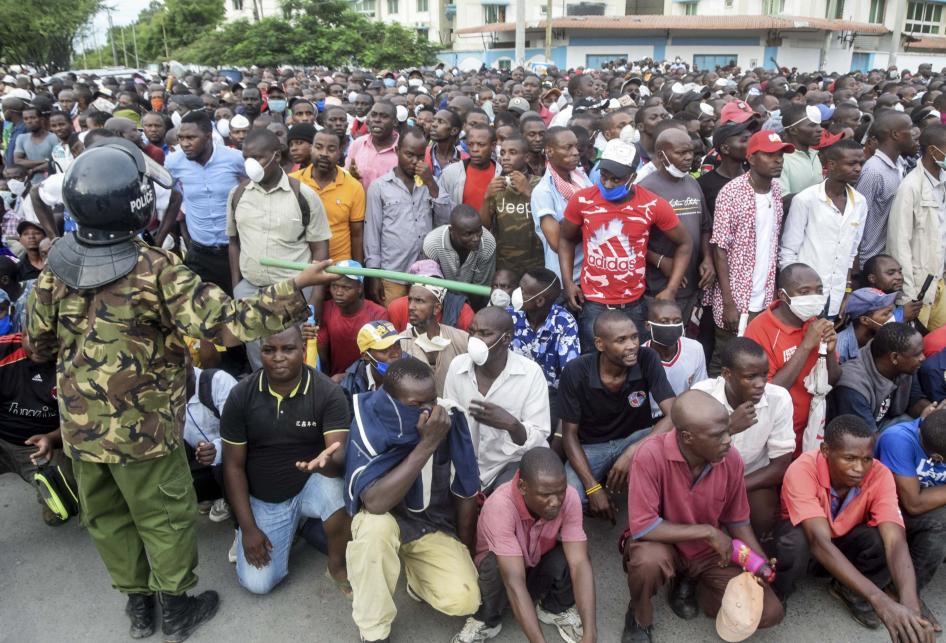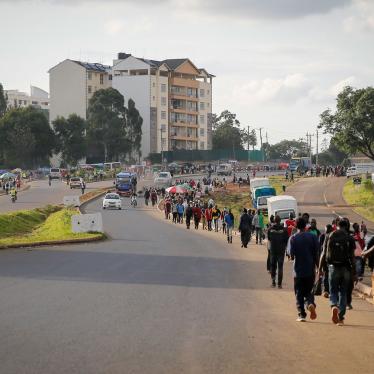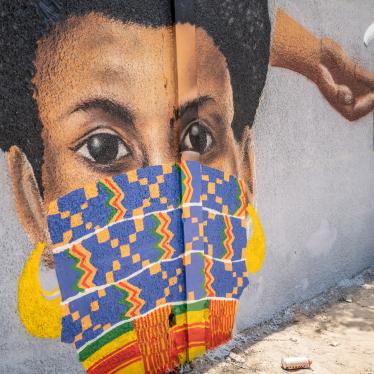(Nairobi) – At least six people died from police violence during the first 10 days of Kenya’s dusk-to-dawn curfew, imposed on March 27, 2020 to contain the spread of Covid-19, Human Rights Watch said today.
The police, without apparent justification, shot and beat people at markets or returning home from work, even before the daily start of the curfew. Police have also broken into homes and shops, extorted money from residents or looted food in locations across the country. On March 30, following criticism from various groups over abuses in Mombasa, including by Human Rights Watch, President Uhuru Kenyatta apologized generally about police use of force, but did not instruct the police to end the abuses.
“It is shocking that people are losing their lives and livelihoods while supposedly being protected from infection,” said Otsieno Namwaya, senior Africa researcher at Human Rights Watch. “Police brutality isn’t just unlawful; it is also counterproductive in fighting the spread of the virus.”
Between March 29 and April 14, Human Rights Watch conducted phone interviews with 26 witnesses, relatives, and victims of abuses related to the curfew in Nairobi, Mombasa, Kwale, Busia, Kakamega, Mandera, and Homa Bay counties, revealing severe police abuses in these communities.
On March 25, President Kenyatta announced a government plan for a nationwide dusk-to-dawn curfew starting March 27. Police appear to have enforced it in a chaotic and violent manner from the start. In downtown Nairobi, police arrested people on streets, whipping, kicking, and herding them together, increasing the risks of spreading the virus. In the Embakasi area of eastern Nairobi, police officers forced a group of people walking home from work to kneel, then whipped and kicked them, witnesses told Human Rights Watch.
In Mombasa, on March 27, more than two hours before curfew took effect, police teargassed crowds lining up to board a ferry back home from work, beating them with batons and gun butts, kicking, slapping, and forcing them to huddle together or lie on top of each other. Video clips on local television stations and social media showed that the police were not wearing masks and other protective gear, which authorities were encouraging everyone to wear and have since made mandatory.
Human Rights Watch heard similar accounts from many parts of the country as police violently enforced the curfew over the following days, shooting, beating, and extorting money from people. The violence killed at least six people.
On March 31, at around midnight in the Kiamaiko neighborhood, in Nairobi’s Eastlands area, the police shot live ammunition at Yassin Hussein Moyo, 13, hitting him in the stomach and killing him, witnesses said. His father, Hussein Moyo, told the Kenyan media that his son was standing on the third-floor balcony at midnight alongside his siblings when the bullet struck him.
The Independent Policing Oversight Authority, a civilian police accountability institution, on April 2 said it has started investigating Moyo’s killing. However, similar promises in the past have not resulted in prosecution. In 2017, the oversight authority promised to investigate the killing in Kisumu of Samantha Pendo, 6 months old, and, in Nairobi, of Stephanie Moraa, age 9, by police around the time of the presidential elections. But no officer has been charged with either killings or in any of the more than 100 cases of killings Human Rights Watch documented in that period.
In Busia and Kakamega counties, in western Kenya, the police have also beaten and shot at people, in many cases outside the hours, resulting in death and serious injury, local residents told Human Rights Watch.
In Kakamega county, at around midday on April 1, police enforcing a ban on the open-air market arrived in trucks at the market in Mumias and began beating, kicking, and shooting at traders. Three traders at the market told Human Rights Watch that Idris Mukolwe, a 45-year-old tomato vendor, died from being hit with a teargas canister police threw at him. One trader said:
We ran when the police arrived, but they threw teargas at us. One teargas canister hit Mukolwe and exploded in his face. He started suffocating as police laughed at him, and when we went to his aid, police again threw teargas at us, forcing us to flee.
At the same market on March 30, police shot a 24-year-old trader, Grace Muhati, with live ammunition. Fellow traders rushed her to a county referral hospital, where she is recuperating after doctors removed two bullets from her body, a family member said.
Human Rights Watch was able to confirm a second man was beaten to death by police in Kakamega, a third in Homa Bay, western Kenya, and two more in Kwale county, in the coastal region.
Kenyan authorities should urgently investigate instances in which police shot, beat, or abused people, killing or seriously injuring them, and hold those responsible to account, Human Rights Watch said. Under Kenyan and international law, police may only use lethal force when it is strictly necessary to save lives.
Kenya has a long history of police use of excessive force during law enforcement operations, either in informal settlements or in response to demonstrations, often resulting in unnecessary deaths. In February, Human Rights Watch documented eight cases of police killings, six of them during peaceful protests. One was in Majengo against the police killing of a 24-year-old man and another in Kasarani against the poor condition of roads in Nairobi’s low-income neighborhoods of Majengo, Kasarani, and Mathare. There was apparently no justification for these killings.
In February 2018, local and international rights organizations, including Human Rights Watch, documented more than 100 cases of police killings of opposition protesters during the 2017 presidential elections. In June 2016, Human Rights Watch found that at least five people died and 60 more were wounded by gunfire in the Nyanza region as police tried to obstruct two protests calling for reform and reconstitution of the electoral body.
Although many killings by the police have been well documented by both state institutions and rights organizations, the security officers have rarely been held to account, including by the police oversight authority. Those responsible for investigations appear to focus only on one or two cases that have elicited public outrage and ignore the rest. The police authorities and the oversight body have a responsibility to ensure that all current and past killings are thoroughly investigated and that all those implicated are held to account in line with Kenyan law, Human Rights Watch said.
“Kenyan authorities should ensure that the police do not use excessive force and that the curfew is carried out legally to benefit Kenyans,” Namwaya said. “The Kenyan authorities should follow through on promises to investigate the killings and abuses and hold those responsible to account.”
For further details of the abuses Human Rights Watch documented, please see below.
The Curfew Killings/Deaths
Kenya’s curfew to curb the spread of Covid-19 went into effect on March 27. Within the first10 days, police used excessive force across the country, causing the deaths of at least six people and leaving many others injured, Human Rights Watch found. The 26 people Human Rights Watch interviewed included victims of police beatings, witnesses, relatives of the victims, including those killed, and activists involved in seeking justice for the victims and their families.
Calvin Omondi, 23, March 27, Homa Bay County, Western region
A witness in Rachuonyo, Homa Bay County, western Kenya, said that Omondi, a motorcycle taxi driver, died on March 29 at Rachuonyo Level Four Hospital in Oyugis from injuries following police beatings on March 27, the first day of the curfew. Relatives said that Omondi was returning to his house at around 7 p.m., the official start of the curfew when a group of officers attacked him at a trading center in Homa Bay, causing him to lose control of his motorcycle. But the area police commander, Esau Ochorokodi, told media that police were not involved in his death and that Omondi lost control of his motorcycle and hit his head on a bridge.
Hamisi Juma Mbega, 49, March 28, Kwale County, Coast region
A relative and two activists said that just before 7 p.m., Juma, a 49-year-old former police officer who is a motorcycle taxi rider, volunteered to take a woman in labor to Mwahima hospital, Kwale county, in the coast region. On his way back to his house in Zibani village in Matuga constituency, relatives said, a group of police officers, stopped him, beating him with rifles and gun butts. A relative, Omar Abdallah Raisi, said that the police first threw teargas at Juma, a father of four, in the middle of the road at Mkunamnazi, Likoni: “He lost control of the motorcycle and fell. Police then just started beating him, leaving him for dead.”
Moyo, 13, March 31, Nairobi County
Police shot Yassin, standing on the third floor balcony of a family apartment at night, in the stomach, killing him instantly.
Eric Ng’ethe Waithugi, 23, April 1, Kwale County, Coast region
Two witnesses and one activist said that more than 20 police officers beat Eric Ng’ethe, 23, an accountant at a pub in Ukunda, Kwale county, to death, at around 7 p.m. on April 1. One witness said that Ng’ethe was at work, but that he and other young men locked themselves inside the pub when curfew hours approached. The officers shot teargas into the pub and broke down the door, then beat Ng’ethe and 11 other people inside with wooden clubs. The Msambweni sub county police commander, Nehemiah Bitok, told Kenyan media that Ng’ethe died in a stampede after the people inside allegedly defied police orders to open the pub.
Yusuf Ramadhan Juma, 35, April 1, Kakamega County, Western region
The family of Ramadhan Juma, who had a mental disability, said he left their home on the evening of April 1 and never returned. One family member said they searched for him the next morning and found him in Kakamega County Referral hospital with serious injuries they believed were from beatings during curfew the previous night. Juma died just moments after the family found him. Kakamega central divisional police commander, David Kabena, told the media that the police were not responsible: responsible: “We have heard that the deceased had mental problems,” he said. “Maybe he went out there touching other people’s property and was beaten by people who didn’t know he was sick.”
Idris Mukolwe, 45, April 1, Kakamega County, Western region
Relatives and fellow traders at Mumias market told Human Rights Watch on the phone that Mukolwe, a tomato vendor, was hit by a teargas canister thrown at him by police who were dispersing traders due to the open-air market ban imposed by the county government of Kakamega. One of the traders narrated how Idris remained down after he was hit by canister, and as he struggled to stand up, the officers laughed and mocked him. He collapsed moments later and died at the scene, according to the traders.
Beatings and Extortion by the Police
Human Rights Watch also documented instances of harsh beatings and extortion. Two victims of police beatings said that, on March 28, seven police officers forced their way into a block of six units, including a shop and a pub, in Nairobi’s Kayole neighborhood, Matopeni area, dragged the owner of the building, a middle aged disabled man, from his shop, and started beating him and his wife. The victims said that other officers pulled down the building’s doors and beat the tenants. One victim said: “They beat us from 8 p.m. up to 10 p.m. and then started taking valuables, mostly electronics, from houses, the pub, and the shop.”
In another incident, a middle-aged man from Kipevu, in Mombasa County, said that on April 1 he ran into a group of police officers at about 7 p.m. at a grocery shop not far from his house. He said two of the police officers confronted him and started beating him with black leather whips. “They all started beating me,” he said.
“Some were hitting me with batons, others were just kicking and punching me. I could not tell how many they were. Others were beating other people near me. It was around 7:20 p.m.”
Another man, 26, from Mombasa’s Mwangulu area in Lungalunga, said that on April 2 police stormed into his compound at around 7:20 p.m. and beat him with whips. He had just stepped out of his house to go to the latrine within his compound when police started beating him, saying he had violated the curfew by being outside at that time. He was injured on his back, hand, and neck.
In Nairobi’s Eastleigh neighborhood, a middle-aged businessman said that police beat him, then put him in the trunk of his car, and drove around the neighborhood with him for three hours, releasing him only after he bribed them with Ksh2,000 (approximately US$20).
In Mandera county, in northeastern Kenya, a 35-year-old man said that National Police Reservists officers, a force recruited from local people whom police train to assist them in maintaining law and order in villages across the country, forced their way into his car and started driving him to the police station an hour before the start of the curfew. The officers beat him when he asked why they had arrested him before the curfew. He shared pictures of serious injuries he sustained on legs, hands and back with researchers.
In Busia county, residents said police have been conducting curfew enforcement operations during the day, raiding homes where local alcohol is brewed and sold, and arresting people, whom they later release after they pay bribes of between Ksh2,000 and Ksh5,000 ($20 and $50), depending on negotiations. In a village not far from the town of Busia, a 27-year-old motorcycle taxi driver said that on the afternoon of March 29, the police stopped him and beat him for no apparent reason. He said he had serious injuries all over his body.










